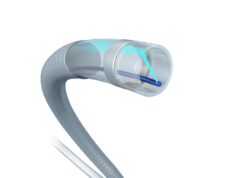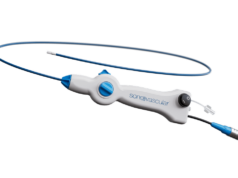
In a prospective, controlled clinical trial of deep vein thrombosis (DVT) triage using artificial intelligence (AI)-guided software simulating compression ultrasonography, lead investigator Efthymios Avgerinos (University of Athens, Athens, Greece) and colleagues demonstrated a high sensitivity and specificity in DVT diagnosis. The researchers concluded that the machine learning software was able to aid non-experts in acquiring valid ultrasound images of venous compressions and allowed safe and efficient remote DVT triage. Avgerinos recently presented these findings at the 22nd European Venous Forum (EVF) annual meeting (30 June–2 July 2022, Venice, Italy).
Diagnostic algorithms for DVT typically require a clinical probability test assessment, a standard lower leg duplex or, at a minimum, two-point compression ultrasound and D-dimer testing. These can be time consuming for both patients and physicians in an otherwise busy emergency room or vascular ultrasound lab, Avgerinos told Venous News.
AutoDVT (ThinkSono), a machine-learning software, is an AI tool guiding non-specialists in acquiring appropriate two-point (common femoral and popliteal veins) compression sequences. At EVF, Avgerinos detailed that a smartphone or tablet and a wireless ultrasound probe are the only equipment needed to use this technology, and that users upload captured images to the cloud, which are then reviewed remotely by an expert.
In Avgerinos et al’s study, the investigators recruited patients with a suspected DVT at two tertiary centres: Magdeburg, Germany and Athens, Greece. Enrolled patients underwent an AutoDVT scan by a non-ultrasound-qualified healthcare professional prior to the standard duplex scan. Two to four external qualified physicians blindly reviewed images collected by the software that had been uploaded to a cloud-based platform. All reviewers, based on these images only, rated all sequences on the American College of Emergency Physicians (ACEP) image quality scale (score 1–5, with a rating of three or above defined as sufficient diagnostic quality) and made a triage decision: low or high risk for DVT. Categorisation was compared to DVT diagnosis by the standard duplex scan.
Addressing the EVF audience, Avgerinos reported that three nurses scanned 37 patients (age 63.7±17.01, body mass index [BMI] 28.62±5.9, 32% females), resulting in 34 (97%) scans that were judged to be of diagnostic quality. Average ACEP scores were 3.88±0.43, and there was no significant difference in the proportion of diagnostic quality of scans between reviewers or scanners, the presenter relayed.
In addition, Avgerinos communicated that AutoDVT triaged 23 (62%) scans as negative, all of which the standard duplex scan confirmed as negative. Of the 14 patients triaged as high risk, seven were positive for DVT. These results accounted for a sensitivity of 100% and a specificity of 77% for DVT diagnosis.
Speaking to Venous News after the presentation, Avgerinos summarised the key findings of the study: “The machine-learning software was able to aid non-experts in acquiring valid ultrasound images of venous compressions and allowed safe and efficient remote triaging. Given that the vast majority of the requested DVT scans are negative, such a triaging strategy allows faster diagnosis and treatment of high-risk patients and can spare the need and cost of multiple unnecessary duplex scans. Patient waiting times can be reduced, and radiologist and sonographer resources can be reallocated.”
“The ThinkSono investigators are excited to evaluate these findings on a larger scale,” the presenter added, noting that several European sites are incorporating this new technology and commercial pilots are underway.









